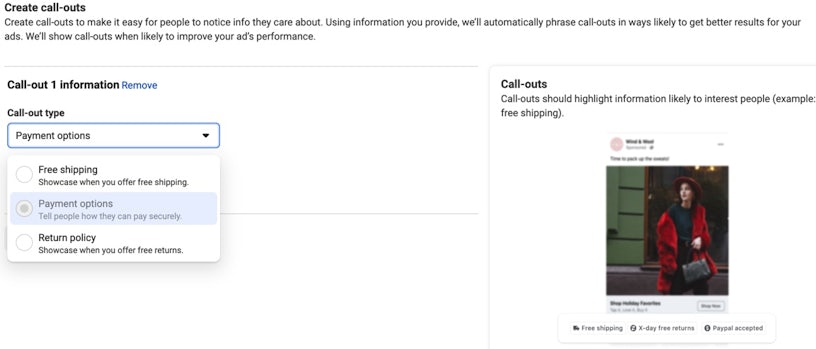New year, new paid social updates! With 2022 well underway, it’s important to keep on top of the latest developments in the world of social media, and what it might mean for your business. Read on to discover the top insights you can use to keep your paid social strategy strong in 2022.
In this month’s post, we explore:
- Changes to Meta’s ad campaign set-up process
- New call-outs feature available on Meta
- Instagram tests algorithm-free, reverse chronological feed
- New opportunities for social issue ads on Meta
The traffic light imagery indicates the importance of each update – red denoting a priority update that requires your attention, green representing a less important update that you should be aware of and amber lying somewhere in the middle.

Changes to Meta’s Ad Campaign Set-Up Process

It’s official: the Ads Manager interface is being redesigned. In order to simplify the campaign set-up process, Meta is streamlining its ad objectives by focusing on the most relevant selections.
The key difference is the reduction in objective options from 11 to 6, and a move away from the ‘awareness’, ‘consideration’ and ‘conversion’ banners.
According to Meta, the new outcome-based system will allow marketers to “select their designed business outcomes (e.g. awareness, traffic, engagement, leads, app promotion, sales) and the interface will guide advertisers to the most optimal campaign setup/creation paths to achieve that outcome.” These changes will gradually be rolled out throughout 2022.
What does this mean for me?
The new simplified at set-up process could be useful for marketers, helping to better align campaigns with desired objectives whilst avoiding objective duplications. However, removing 5 objective options could be limiting in some ways, too.
According to Meta, the new system will allow marketers to communicate their goals more easily as the objective options are applied to more widely-applicable marketing goals. Ads manager will then be able to provide more guidance during the campaign set-up process to make it easier for advertisers to achieve their marketing objectives.
We won’t know for sure how this update will impact advertisers until the interface is launched – which is due to take place this year.
New Call-outs Feature Available on Meta

Meta has introduced a new, dynamic call-outs feature in Ads Manager that allows advertisers to showcase certain features in their ads – free shipping, payment options and return policies – which may be helpful in increasing conversions. Crucially, the feature is currently only available in ‘website traffic’ and ‘conversions’ campaign objectives, and it will only display on mobile devices through Facebook Newsfeed.
The feature is currently limited to some ad accounts, and is due to launch for all accounts soon. To find out whether you have access to call-outs, head to the ad level of your campaign – it will appear below the ad copy fields. Upon setting up call-outs, you will find 3 options available:
- ‘free shipping’, to highlight that your business offers this benefit;
- ‘payment options’, to showcase how prospects can pay for your product or service;
- ‘return policy’, to notify users that your business offers free returns.
You can select up to all 3 for your ad.
As this is a dynamic feature, Facebook’s machine learning system will phrase the call-outs in ways likely to generate better results using the information provided. Callouts will also only be shown when it’s likely to improve ad performance.

What does this mean for me?
This new feature will be particularly beneficial for ecommerce advertisers in highlighting some key product benefits that may increase sales. Unfortunately, there is no reporting metric for call-outs as of yet. To determine their effectiveness for your business, we would recommend split-testing ads with call-outs against the same ads without this new feature; reviewing performance after allowing the ads to run for some time.
For now, the call-outs feature is currently limited to 3 options, but we hope to see Facebook introducing some additional variations to further boost conversions once the feature becomes more established.
Instagram Tests Algorithm-Free, Reverse Chronological Feed

Instagram chief Adam Mosseri has confirmed that the social media platform is working on a new chronological feed, allowing users to see posts from accounts they follow in chronological order.
Instagram is introducing two new feed options that users can alternate between – ‘favourites’, which will enable users to view accounts based on those added to a favourites list; and ‘following’, which will display accounts followed, free from recommendations, in reverse timeline order. Crucially, Mosseri has revealed that the algorithm-based ‘home’ feed will feature ‘more and more recommendations over time’, as Instagram seeks to increase content discovery and incentivise users to spend more time, and therefore money, on the platform.
The new feed options are currently being tested, with the aim to roll out the feature in the first half of 2022.

What does this mean for me?
Whilst Instagram hasn’t confirmed how this will impact sponsored content, this update could present challenges for advertisers, in reducing the possible reach of ads if users opt to view their feed in the ‘following’ option. It could also pose difficulties for content creators in limiting chances of content discovery.
However, Mosseri also noted that users will not be able to select a default feed option – meaning they will need to manually switch over to the ‘favourites’ or ‘following’ feed each time they open the app. This then poses the question – will most users continue to use the algorithm feed? If so, with more content recommendations, this could potentially increase sponsored content and therefore ad reach on the app.
Crucially, Facebook already provides the same options Instagram is now introducing, with users having to manually select the chronological feed. Unfortunately, there is currently no available data outlining the uptake of this feature, and how this has impacted social media usage; however, in an internal 2014 study, Facebook found that allowing users to turn off the algorithm resulted in less time spent on the app.
Essentially, we won’t know for sure how this update will impact advertising on the platform until the new feed options are launched.
New Opportunities for Social Issue Ads on Meta

In recent years, Meta has received resistance against its social issue ad requirements. In a move that will benefit several ecommerce brands, Meta is changing how social issue ads are categorised in Ads Manager.
Ads that have a primary purpose to sell a product or service will no longer be categorised as social issue ads. As a result, these ads will not need to go through an authorisation process or have a ‘paid for by’ disclaimer if they meet the below criteria:
- A product or service is prominently shown in use or named in the ad
- The primary purpose of the ad is to sell a product or promote a service, even if the ad content discusses a social issue
- The ad content contains a call-to-action to purchase or use the product or service
However, the update will not apply to ads that focus on politics or legislation. Moreover, if the promoted product in an ad features social issue advocacy, or if 100% of profits are donated towards a social cause, Ads Manager will still require authorisation and the ‘paid for by’ disclaimer.
You can find out whether your business meets this criteria here.
What does this mean for me?
This update will largely benefit ecommerce advertisers, who will experience fewer restrictions when creating social issue ads that have a primary purpose of selling products or services. Accounts, people and pages running ads that meet the criteria won’t need to go through an authorisation process, and ads will not need to include a “paid for by” disclaimer.
However, there are some grey areas. If you were to run an ad where a portion of proceeds are donated to a social cause, the ad *might* not require a disclaimer. In another example provided by Meta, if your ad promotes a product and a CTA but includes social issue advocacy messaging, it would still require a disclaimer. It’s likely that there will be some confusion around the new policy, but the key message is that Meta wants to make it easier for more brands to run ads on the platform.
Whilst this isn’t the most clear form of guidance, we would encourage marketers to take advantage of the new policy to see how it affects your paid social ads. Each ad is still subject to review, and if your ad does advocate social issues, you can still run it – but you’ll need to go through the same authorisation process.
Keep an eye out for our next blog post for more paid social industry updates. Can’t wait? Get in touch to discuss your paid social campaigns for 2022.



